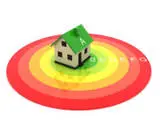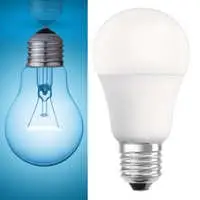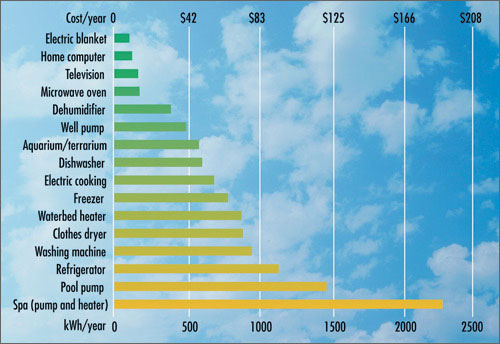Energy Saving Tips
- How much in Energy Savings are you missing out on?
- Where can more energy be saved with simple changes?
- What low cost changes will be a good return on investment?
- Which energy saving tips could save you $100s each year


See what ideas suit you best. Use Energy Calculators section to more accurately work out your potential savings in advance. Consider measurement to compare the before and after energy savings.
| Lighting | Hot Water | Cooling | Heating |
| Entertainment | Computers | Appliances | Timers |
| Measurement | More Information | ||
Lighting

- Change light bulbs for light emitting diode lights (LED), save up to 85% on electricity. Many shapes, sizes and power ratings are available in LED's.
- Turn off lights when you leave a room.
- Use sunlight instead of artificial light if available. Consider skylights for light and hot air removal. Skylight Information.
- Use lower wattage fluorescent tubes with electronic controllers (ballasts) and save 33%. Sample Fluorescent Systems.
- Consider replacing halogen light fittings for compact fluorescent lights that fit in the same area.
- Consider external solar lighting options. No wiring or electrician required. Outdoor Solar Lighting article.
- Local Light Energy Calculator
Hot Water

- Install water saving shower rose and tap aerators to save over 50% on hot water.
- Try to limit showers to 4 minutes to save on hot water.
- Fix any water leaks promptly. They can add 20000 litres per year to your usage.
- Work out how much hot water you use per year and see if solar hot water is cost effective.
- Other hot water alternative include electric heat pump or gas hot water systems.
- Local Hot Water and Solar Hot Water Calculator
- Water Rating Labeling Scheme
Cooling
- Insulation can control up to 60% of heat transfer in and out of your house. This can reduce household temperatures by 8 to 12 degrees C. Insulation Examples.
- Window tinting can reduce solar radiation by 80%. This can reduce the sun's heat entering your premises.
- Power roof ventilation can reduce roof loft temperature by 5 degrees Celsius. Lowering the loft temperature help reduce heat transfer into your house. Example.
- Roof solar barrier paint can reduce building temperatures. This is easier to apply especially on flat roofs compared to bulk insulation.
- Use natural breezes and fans instead of air conditioners where possible. Air conditioners can be assisted with fans for air circulation and heat removal.
- External water bodies can assist in cool breezes.
- External shading or landscaping can reduce cooling requirements. By preventing the sun's heat striking the building helps keep a building cooler.
- Clean air conditioner filters to improve efficiency.
- Consider running bedroom air conditioners on off peak electricity. This could save $100s per year. Most hours spent in a bedroom are off peak times where the power tariff is for example 1/3 less cost than the full time power tariff.
- Reducing general electrical consumption can also lower cooling requirements.
- Geothermal heat pumps uses the stable temperatures deep in the ground to control the house temperature. Geothermal Heat Pump Example
- Use schedule or countdown timers to control energy consumption.
- Passive Cooling House design principles.
- Best Air Conditioning Energy Star rating for cooling and heating
Heating
- Insulation can prevent 60% of heat loss out of a building. Insulation Selection.
- Stopping draft through exhaust fans that are off with a self closing shutters can save 20% in heating and cooling. Example Products.
- Set cooling for 24 degrees Celsius and heating at 20 degrees Celsius. Further Reference.
- Control the area cooled or heated by closing doors, windows and stopping drafts. This reduces the volume needing conditioning and reduces losses.
- Choose glazing to suit the local climate. Glass choice may vary for North, South, East and West aspects. Window Energy Rating Scheme
- Consider solar air or water heating to be used for heat transfer into rooms. Solar Air Heating Example
- Gas and reverse cycle heating are more efficient than standard electric heaters.
- Consider co-generation which uses gas for heating and electricity generation. Sample Product
- Use schedule or countdown timers to control energy consumption.
- Glazing Insulation Performance Information Reference
- Passive solar heating house design principles.
- Heating types and design principles.
- Home heating guide with running costs
Entertainment
- Hifi equipment with switched mode power supplies and neodymium magnet speakers are far more efficient electrically. Advanced speaker case design helps with efficiency.
- Consider placing a rooms entertainment equipment on one power board and switching it off at the wall when not in use.
- Appliances can be controlled by remote controlled power boards if power point access is difficult.
- Adjust the brightness of TV's to suit the environment. Full brightness often set as the manufacturers default will use more energy.
- Turn off gaming consoles at the wall when not in use and save up to $200 per year. PS 3 and Xbox 360 have high standby power consumption.
Computers
- Turn on computer power management with screen power down at 15 minutes and computer sleep in 30 minutes of inactivity.
- Control computer peripherals with a single power board turned off at the wall when not in use. USB controlled power boards are also available that are only on when the computer is on.
- Choose a laptop instead of a desktop and save over 50% in energy costs. Also consider desktops with energy efficient processors (often in small cases).
- For light computing needs consider a Chromebook. This looks like a laptop, uses cloud (Google) computing resources and uses about 15 watts.
- Buy computers with Energy Star 4 or 5 rating and include 80 Plus standard power supplies (> 80% efficient).
- For business groups consider thin client computers with a server (local or remote). This will save energy and avoid PC replacement cycles.
- Adjust the monitor brightness lower to suit the environment and also save electricity.
- Local Computer Energy Calculator
- Local Computer Power Consumption Calculator based on parts
- Green IT techniques chapter
Appliances
- Using cold water for the washing machine makes savings of 50 - 150 litres of hot water heating costs per load.
- Use clothes line rather than dryer. Save about $100 per year.
- Clean dryer filters regularly to improve efficiency. Consider ducting hot dryer air out of the house to save on cooling.
- Turn off fridges that do not need to be in use. Save about $100 for each fridge turned off per year. Modern fridges use less energy. Reference
- Look for new appliances with 1 watt standby and are top performers in Energy Stars. Top Energy Star Award Appliances
- Disconnect any battery chargers than are not in active use.
- Local Appliance Energy Calculator
- Best Washing Machine and Dryer Energy Star Comparisons

Timers
- Consider daily, weekly, countdown timers or sensors to limit lighting hours.
- Run a timer on a pool pump and save approximately $1000 per year.
- Countdown timers can be used for classrooms, stairways, walkways, exhaust fans etc.
- Any device with a moderate standby power consumption may benefit from a timer.
Measurement
- Consider measuring electricity consumption to accurately measure the saving. Actively try to keep a lower average consumption.
- $25 for power point measurement.
- $100 for building power measurement.
- $150 for large building 3 phase power measurement.
- Energy measurement introduction chapter
More Information

- Energy Saving Guide PowerPoint
- Solar Power Calculator. Does solar power give you a good return on investment?
- Energy Efficiency Section
- Matthewb Homepage
- Greener Housing Design Site
What energy saving tips suit you?